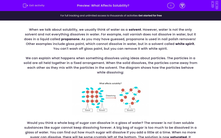A mixture contains different substances that are not chemically joined to each other. You can have a mixture containing pretty much anything - a mixture of gases, a mixture of two different solids, like iron fillings and sulfur powder, a mixture of a solid dissolved into a liquid, so many possibilities!
Let's think about dissolving.
We can explain what happens when something dissolves using ideas about particles. The particles in a solid are all held together in a fixed arrangement. When the solid (the solute) dissolves, the particles come away from each other as they mix with the particles in the liquid (the solvent).
The diagram shows how the particles behave while dissolving:
.png)
A solid has to be soluble to dissolve in a liquid. When we talk about solubility, we usually think of water as a solvent. However, water is not the only solvent and not everything dissolves in water.
For example, nail varnish does not dissolve in water, but it does in a liquid called propanone. As you may have guessed, propanone is used in nail polish removers!
Other examples include gloss paint, which cannot dissolve in water, but in a solvent called white spirit. You can't wash off gloss paint, but you can remove it with white spirit.
Would you think a whole bag of sugar could dissolve in a glass of water? The answer is no! Even soluble substances like sugar cannot keep dissolving forever. A big bag of sugar is too much to be dissolved in a glass of water. You can find out how much sugar will dissolve if you add a little at a time.
When no more sugar can dissolve, there will be some crystals left at the bottom. The solution is now saturated. It contains as much dissolved solid as it possibly can.
Want a bit more help with this before you begin? Why not watch this short video?








